Trekking in Nepal can be intimidating, thanks to the lofty peaks (um, Mount Everest) imposing shadows across the dipping valleys. But fun fact: beginner and regular trekkers can take on several treks across Nepal, including the Annapurna Base Camp Trek.
This stunning trek brings hikers up through magnificent alpine terrain to one of the gems of the Himalayas; the amphitheater of mountains known as the Annapurna Sanctuary. Also known as Annapurna Base Camp, this area is used as the basecamp for climbers intending to climb the namesake mountain or others in the area. Following a well-trodden path, and with many options for sleeping along the way, this trek is an easy choice for experienced and inexperienced trekkers alike.
You might feel frightened standing below the massive Annapurna mountain range, but as this trek only takes you to the base camp there is nothing to worry about! Advanced trekkers might scoff at this. However, the breathtaking scenery will sweep anyone off their feet!
Read on to learn everything you need to know about the Annapurna Base Camp Trek. Beware: you’ll add this one to your bucket list as soon as you reach the final paragraph.
Table of contents
General Route Information for the Annapurna Base Camp Trek
Annapurna Base Camp Trek Highlights
Annapurna Base Camp Trek Difficulty
Best ways to prepare for the Annapurna Base Camp Trek
Annapurna Base Camp Trek Accommodations
Food and Drink along the Annapurna Base Camp Trek
Health on the Annapurna Base Camp Trek
Guided tours
Itinerary notes
Annapurna Base Camp Trek Sample Itinerary (From Pokhara)
Trekking in Nepal Articles
General Route Information for the Annapurna Base Camp Trek
Everyone needs to know the general route information before going on a trek, right? The following numbers and concrete info will only further convince you to add the Annapurna Base Camp Trek to your list of must-dos.
Start and End of the Annapurna Base Camp Trek
The Annapurna Base Camp Trek sets out from Pokhara, an adventurers’ paradise bordering Phewa Lake. It’s honestly worthwhile to do the Annapurna Base Camp Trek just to stay in Pokhara, where lively and colourful vibes await! Although, more majestic wonder awaits along the trails snaking through Annapurna.
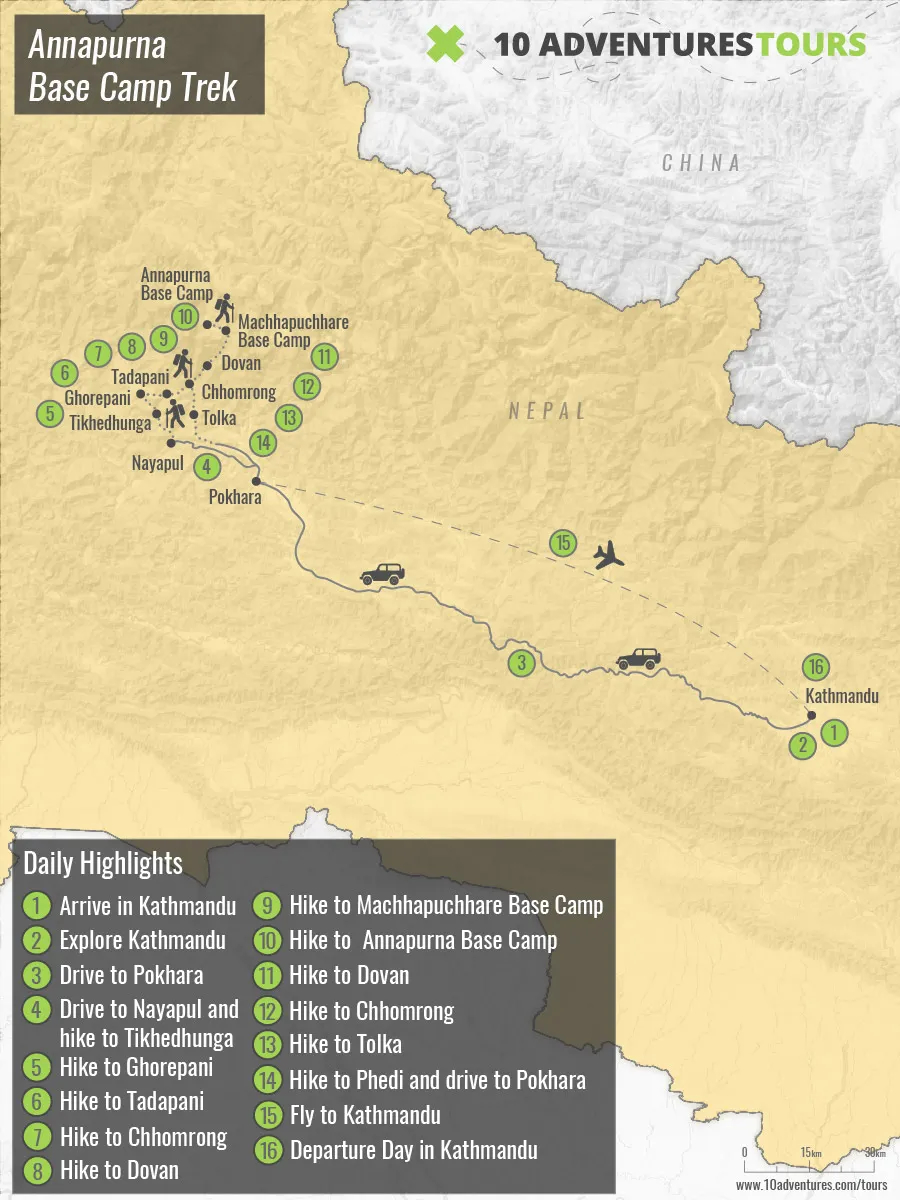
Getting to the Annapurna Base Camp Trek
Fly into the international airport in Kathmandu, the capital of Nepal. Then fly or bus to the major city of Pokhara. We strongly recommend that you take a few days to acclimatize to the high elevation by spending a few days in either Kathmandu or Pokhara. They are both also wonderful cities with very interesting cultures to explore.
Annapurna Base Camp Trek Distance
The trail stretches across 71.5mi, but there’s always the option to take a jeep at the start and end to cut back on some kilometres if you’re short on time. Some people opt for a 37.3mi out-and-back excursion rather than 71.5mi. Expect to hike around six hours a day, covering around 6.2mi.
Annapurna Base Camp Trek Elevation
The Annapurna Base Camp sits at an altitude of 13451ft. We touch more on combating altitude sickness below. Stay tuned! Back to elevation: you likely won’t surpass 4265ft elevation gain in one day, with most days climbing a significantly lower elevation than that.
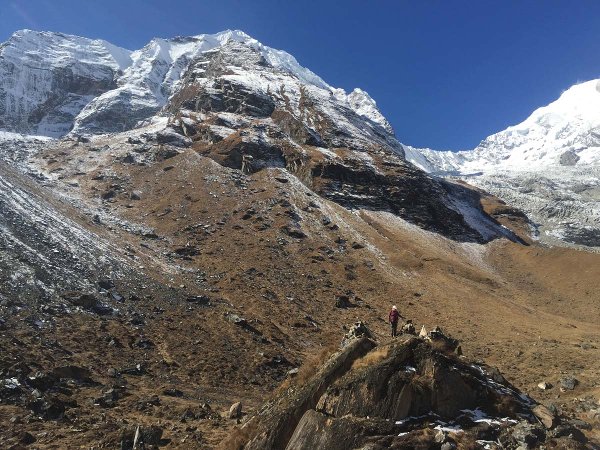
Number of Days for the Annapurna Base Camp Trek
Some people complete the trek in seven days, while others can take upwards of 14 to make their way from start to finish on this out-and-back route.
When to Trek to Annapurna Base Camp
The best times to trek the Annapurna Base Camp differ from typical European and North American meanders. First, it’s essential to avoid the monsoon season! Instead, you’ll find a dry and warm climate (most likely) later in October through November. If that time of year doesn’t work for you, March and April, although wetter, make for a decent backup option.
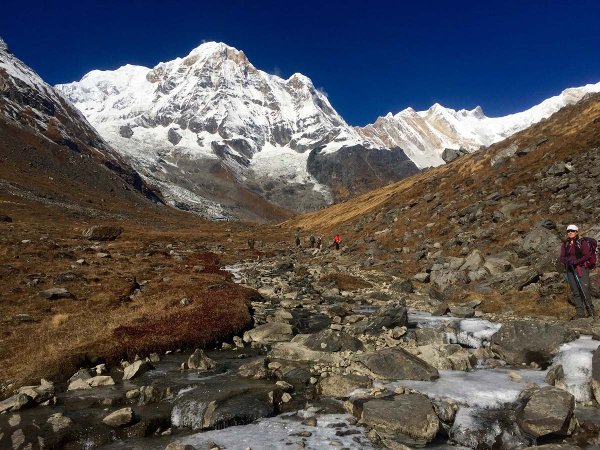
Annapurna Base Camp Trek Highlights
The Annapurna Base Camp unveils natural bliss at every turn, but that doesn’t mean there aren’t some stand-out features worth looking out for! Revel in the four highest peaks towering high above the region: Annapurna I (26545ft), Annapurna South (23684ft), Machhapuchhre (22943ft), and Hiunchuli (21132ft).
But the winning highlight is the Jhinu Danda hot springs, which, since this is an out-and-back trek, grants the chance to rest your muscles in the relaxing water not once but twice.
Along the route, some well-earned highlights, such as Poon Hill, where the sunrise illuminates the soaring mountainscape.
Lastly, if you explore the Annapurna Base Camp Trek route in spring, expect to bask in rhododendron fields. These lovely purple flowers add a magical contrast to the scenery.
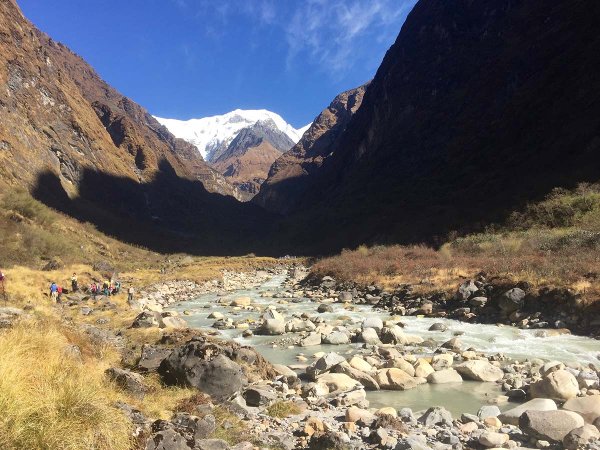
Annapurna Base Camp Trek Difficulty
Most would rank the Annapurna Base Camp Trek as low-moderate difficulty! The trail length may seem daunting, and the heightened altitude may be tough to overcome for some, but the overall trail and minimal technicalities ease the overall difficulty. Most beginner trekkers will enjoy meandering this trail, where a green wonderland cemented by soaring peaks and quaint backcountry villages awaits.
If you’re feeling more of a challenge, the Annapurna Circuit Trek might suit your trekking ideals more than the Annapurna Base Camp Trek.
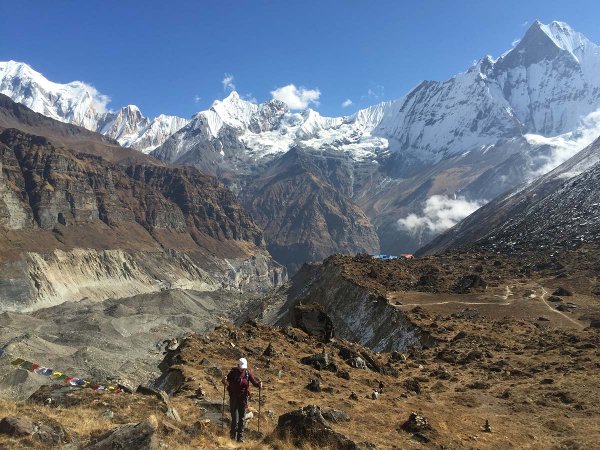
Best ways to prepare for the Annapurna Base Camp Trek
Step one for preparing for the Annapurna Base Camp Trek: get your packing list going. Some things to bring along, on top of the standard clothes, socks, backpack, trekking boots, etc., are:
- Sleeping bag/sleeping bag liner—the teahouses may not wash them every night, so it’s always nice to snuggle into your own bag
- A steripen to sterilize water
- Jacket for the evenings as it can get cold
- Your own refillable water bottle—they stop selling plastic bottles along the trek
- Lightweight towel as the teahouses will not provide you with one
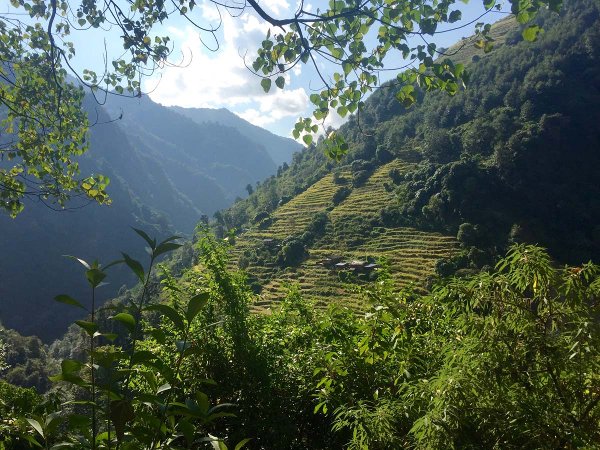
If you forget to pack something, you may find it in Pokhara, the platform town for several escapades, so they know what’s up! While you’re in Pokhara, you’ll also need to grab a TIMS card and permit from the tourist centre. You’re required to hand over four passport photos to obtain these, but you can always get them snapped there.
Once on the trail, you might worry and wonder about altitude sickness. Thankfully, the Annapurna Base Camp Trek doesn’t climb as high as the Mount Everest Base Camp Trek, so you won’t have to stress as much about altitude sickness. Some ways to avoid it are staying hydrated, eating as much as possible, and gaining elevation slowly to acclimatize better. No need to spring up the mountain!
Find out how else to prepare for trekking in Nepal here!
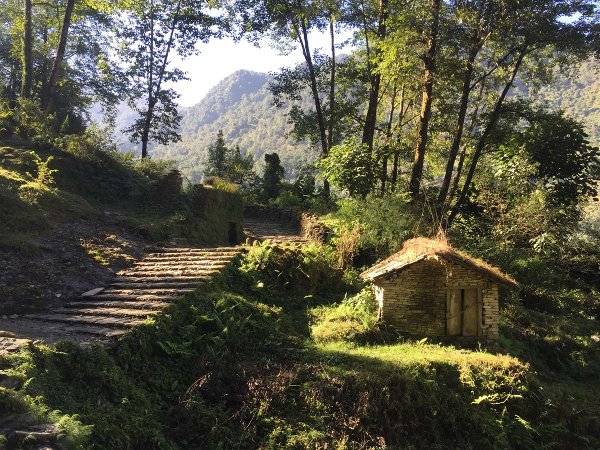
Annapurna Base Camp Trek Accommodations
The Annapurna Base Camp Trek will have you staying primarily in tea houses along the way. Enjoy mixing in with locals as you stay in villages for the first while, followed by more remote stays further along the trek. Most offer a dorm-room style, with two to eight beds in each room. You’ll receive a pillow, blanket, and sheets, but, as we said above, you will need to bring your own sleeping bag – make sure you have a warm one!
You will need to eat wherever you stay, so keep this in mind!
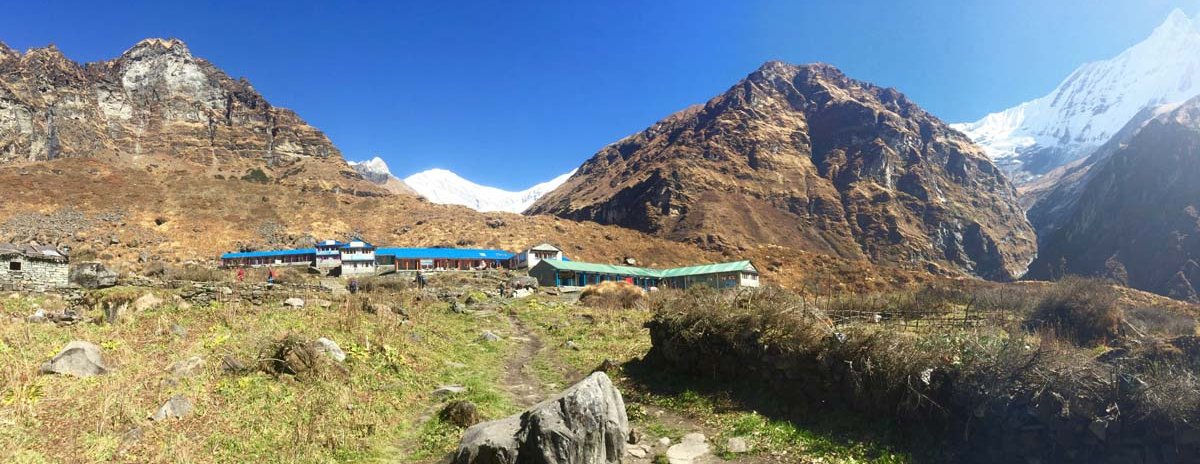
Food and Drink along the Annapurna Base Camp Trek
Speaking of food, the tea houses mentioned above will supply almost all your meals along the trek. They serve pretty basic fare (both traditional and international styles), but the food will fulfill, energize, and please your taste buds. So, expect pasta, toast, noodles, rice, eggs, spring rolls, cereals, and dal bhat (lentil curry). These meals are made fresh when you arrive, which means lunch typically takes over an hour; plan accordingly.
For hydration, you can buy 1L of water from the teahouses or use your steripen to sterilize water from streams or taps further along the trek if you don’t feel like buying water all the time. Remember that plastic bottles don’t exist further up, so bring your refillable water bottle along.
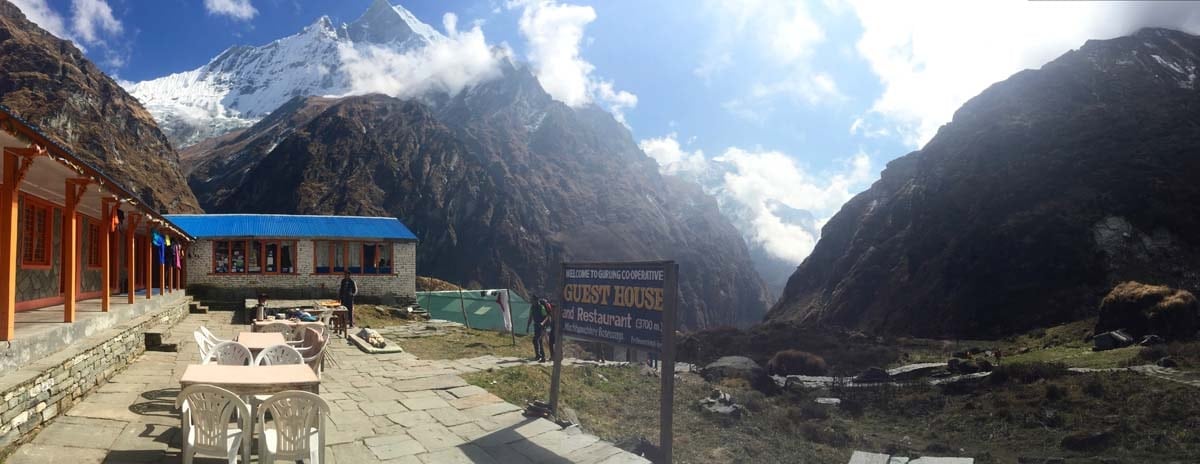
Health on the Annapurna Base Camp Trek
A major concern in any trip to the Himalayas is health. Trekkers should focus on two aspects of health: elevation and stomach bugs.
For many people the elevation will be quite difficult to deal with. Though you may not be covering an immense distance each day, the miles you do feel harder due to the elevation. It is hard to stress how important it is to take time and listen to your body when on this trek. Consider budgeting extra time for the Annapurna Base Camp Trek so that you can hike slowly and not gain too much altitude each day – ideally not more than 300 m gain from bed to bed each day. We also recommend going to a doctor before the trek and getting medication for altitude sickness. These drugs only help with symptoms of elevation, and don’t make your body acclimatize faster.
While in Nepal, it is worthwhile to be very careful of what you eat and drink to minimize the chances of stomach problems. We focus on ensuring everything is cooked thoroughly and served very hot and this has worked well in the past for us. We like fresh dal bhat, fried eggs and piping hot french fries. On our last trip to Nepal this is what we ate every day and we didn’t get sick once!

Guided tours
Planning your Annapurna Base Camp Trek can be challenging, so why not consider booking a guided tour? By this point, you might be wondering if you need a guide to trek this route. The answer? No. This trek is well-signed, so the chances of getting lost are slim. However, if you feel nervous, you can hire your own guide or book a guided tour.
The benefit of booking a guided tour is that you don’t need to think about anything; you can just show up with your backpack and trek! An excellent guided tour to consider booking is the Annapurna Base Camp Trek. This 16-day trek fuses culture and natural wonders. However, consider the Annapurna Circuit Trek guided tour if you’re seeking a more challenging trek.
Another option is to hire a porter to carry some of your gear! But try not to bombard them with stuff you won’t ever use along the trek. Of course, there’s always the option to leave some stuff behind at your hostel in Pokhara.
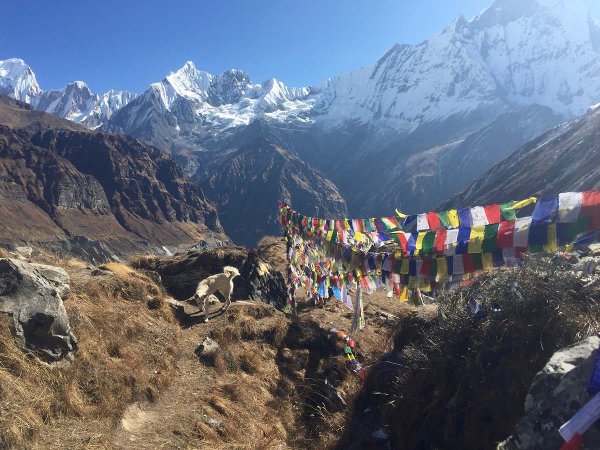
Itinerary notes
The first part of the trek can be a bit dull, so you might like taking either a bus to Kimchi and starting from there or travel by jeep or taxi to Nayapul and start from there. Lastly, you can take a taxi to Gandruk from Nayapul before beginning your trek. You will have to stop at Birethanti and then Chomrong to register your permit!
You can either do the Annapurna Base Camp Trek as an out-and-back venture or stop in Jinhu and take a jeep to Pokhara. It’s also possible to skip out on booking accommodations in advance, but if you’re worried about missing out on a bed for the night, you can reserve a mattress. Not booking in advance gives you some flexibility along the trail, so it’s up to you how you want to go about your trek.
The Annapurna Base Camp Trek is one of the more popular backcountry trekking routes in Nepal—and for good reason. You can’t beat Nepal’s serene backdrop replete with a vibrant culture!
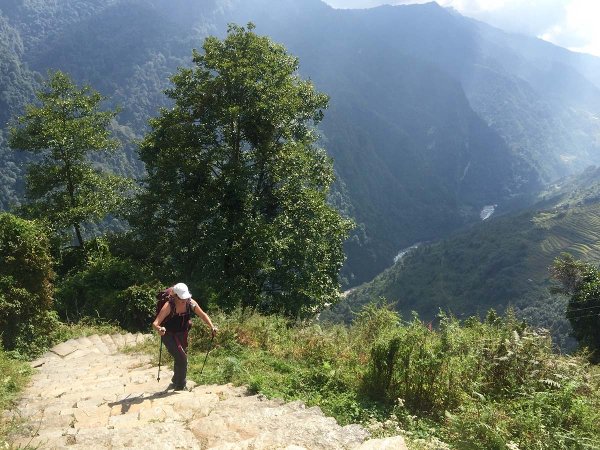
Annapurna Base Camp Trek Sample Itinerary (From Pokhara)
Staircase on the Annapurna Base Camp hike
1. Drive to Phedi and trek to Landrung (5085ft)
2. Chomrong (6890ft)
3. Himalaya hotel (9350ft)
4. Machhapuchhre Base Camp (12139ft)
5. Annapuran South Base Camp (13550ft) [easy day]
6. Doban (8219ft)
7. Ghangruk
8. Kimche then take jeep back to Pokhara
-
Trekking in Nepal Articles
Thinking about a trek in Nepal? Check out these guides to learn more and have an incredible trip to the Himalayas.
Nepal Trekking Guides
- Guide to the Best Treks in Nepal
- When is the best time to trek in Nepal
- How to prepare for trekking in Nepal
Nepal Trekking Route Guides
- Annapurna Basecamp Trek
- Annapurna Circuit
- Everest Base Camp Trek
- Langtang Trek
- Mustang Trek
- Poon Hill Trek
Adventure Tours in Nepal
Check out this selection of great tours in Nepal, from classic bucket-list trekking tours, to unforgettable bike rides through the Himalayas.


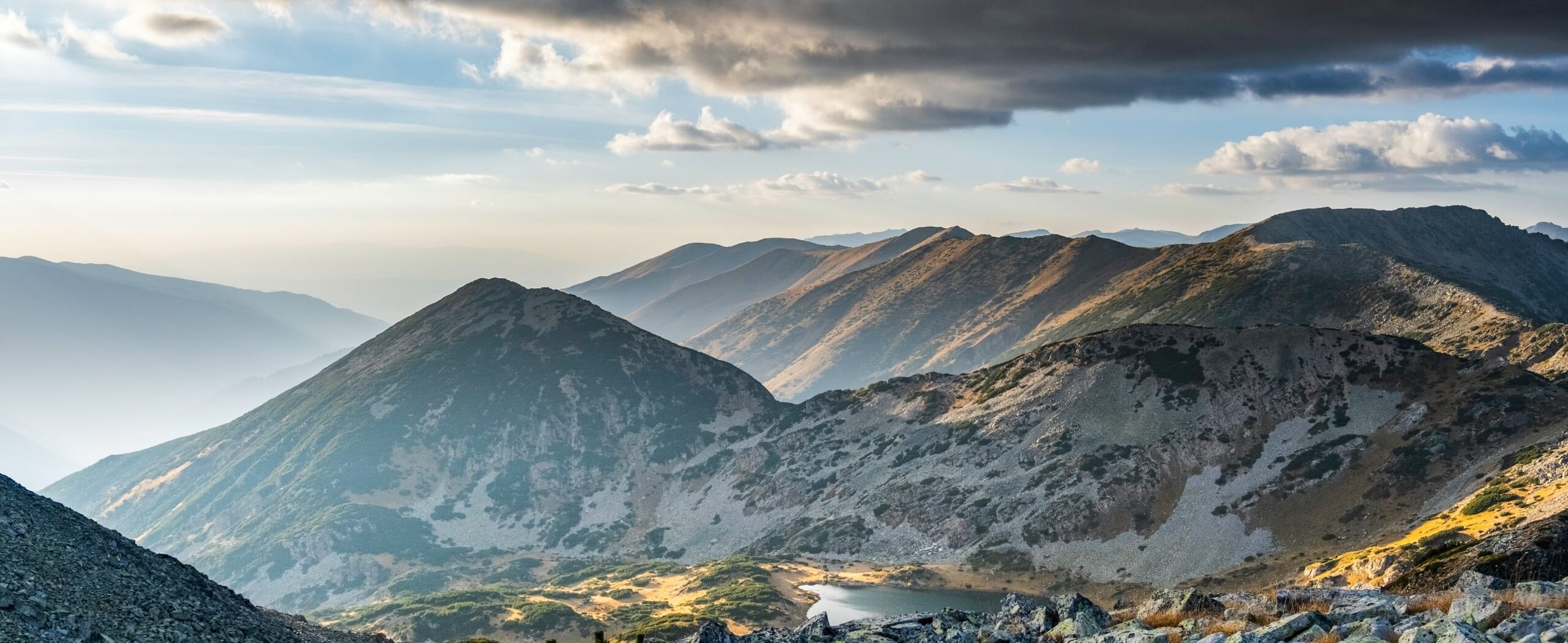


Comments